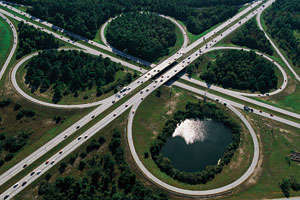When will the madness end?
It’s a question we often ask ourselves when we read about planned highway construction by Tennessee Department of Transportation, aided and abetted by the Memphis Metropolitan Planning Organization.
Here’s the latest: a $30 million cloverleaf on I-40 just over the Fayette County line so the few dozen cars using Tennessee Highway 196 (Hickory Wythe Road) can enter and exit the interstate instead of driving a few miles to an existing interchange — five miles to the east (SR-59) and two miles to the west (New Airline Road) in Shelby County.
In the last presidential election, we heard a lot about the “bridge to nowhere” in Alaska, but back here at home, a “cloverleaf to nowhere” remains on the drawing board. Well, we don’t mean to overstate it; it’s not exactly nowhere – there are probably about 3,500 people in this part of Fayette County.
Smart Transportation
At a time when Tennessee Governor Bill Haslam says that Tennessee’s success depends on Memphis’ success, TDOT and MPO have yet again moved ahead with a massive project that wastes money needed for projects on much, much more heavily-traveled highways in the more populated areas of Memphis.
As we have learned from the single-minded push for I-269, there is little regard given by our road planners and builders about the long-term impact of their projects on the fiscal and economic health of the city that powers the entire region.
According to TDOT documents, Fayette County officials have said that the cloverleaf could attract a shopping center, which should concern Memphis officials because of the potential impact on Wolfchase Galleria. This interchange would make it the first “access point” east of Shelby County.
We remain hopeful that TDOT Commissioner John Schroer will bring a fresh perspective and new thinking to TDOT which has traditionally operated with a working definition of transportation that means more and more highway construction. Mr. Schroer has articulated a smarter philosophy for TDOT in the year since he was appointed by Governor Haslam, but the real challenge for him is to change the culture of an organization that has been dominated for decades by its fealty to the road construction industry.
Unsurprising
The depth of the entrenched thinking becomes clear when reviewing the plans for the interstate interchange on the Hickory Wythe Road in Fayette County. When asked if the interchange was needed because of projected population growth in the northwest corner of Fayette County, it was hardly surprising that Fayette County officials said the cloverleaf is needed. It’s the pro forma answer.
As for building an interchange for the rapidly growing part of Fayette County, it’s worth noting that between the 2000 and 2010 census, the population of Gallaway swelled a grand total of 20 people for a total population of 680. There are no 2010 numbers for Hickory Wythe, an unincorporated community that had 2,600 people in 2000. Braden added 11 people to increase its population to 282 in 10 years.
According to TDOT, the interchange is “consistent with the MPO’s 2026 Long Range Transportation Plan.” It’s yet another indictment of our local MPO, whose operations have been commandeered by suburban and rural interests. As we have pointed out previously, the mayor of Memphis can be outvoted by the mayors of Gallaway and Braden.
Smoking Gun
We wrote a month ago: “If sprawl is a smoking gun, there’s little doubt that MPO’s fingerprints are on the weapon. If there is a poster child for bureaucratic processes that waste time and money, it is the MPO. If there is an agency masquerading as regional that is truly more suburban and rural-dominated, we don’t know of one.
“The fixation on congestion mitigation has produced massive expenditures on roadways that do little to create jobs and new economic development investments while economic arteries are ignored. There are numerous highways in our region that are built to six-lanes to solve congestion that exists for a few hours each weekday. Then there are highways like the vital logistics highway, Lamar, that have been trying for more than a decade to get the attention that it demands and that is vital for economic development.
“Transportation infrastructure spending drives the location of private development, and with a plan directing almost all of this investment outside the I-240 loop, the MPO is creating a self-fulfilling prophecy of continued sprawl and unsustainable growth. Without a comprehensive growth plan and the incorporation of economic development strategies, the current LRTP methodology will continue to perpetuate the same unsustainable pattern that it has for decades.”
We hasten to add, as we have done several times, that we make no criticism of the MPO staff, who labor to do their best in a badly flawed process called one of the most unrepresentative in the country by Brookings Institution.
Cotton Fields Interchange
Back to TDOT, the new Fayette County interchange will be constructed to serve SR 196, “currently a rural two lane, non-access controlled road.” “Land use in the project area is primarily rural with cotton fields and a sod farm,” TDOT wrote.
“Commuters from this area primarily use I-40 to travel to jobs in urban and suburban Memphis areas,” the TDOT report said, failing to point out that once again transportation planning rewards the same people who abandon urban areas and whose decisions are now to be subsidized by the rest of us.
Most damning is the fact that the TDOT “assessments” repeat economic projections as if they are fact and rosy predictions as if they are real. Nowhere can be found any research that calls into question the methodology that unfailing supports the construction of every highway project and misstates and exaggerates the effects of congestion nor do the reports take into account trends lines moving in favor of urban living as a result of gas prices, housing markets, and livability issues.
“The Memphis Area Transit Authority system does not reach this far from the central metropolitan areas,” TDOT wrote. “The closest bus route is over ten miles away.” It’s a self-fulfilling prophecy since TDOT has acted for years that it doesn’t have a significant role to play in public transit.
The Fayette County cloverleaf is a testament to old TDOT thinking and priority-setting. It’s time for TDOT to shift its emphasis from the asphalt lobby to meaningful transportation systems that don’t routinely start and stop with more and more highway construction.




Robert Moses shall have his revenge.
In case no one caught it on the right sidebar last week…
http://www.theatlanticcities.com/housing/2011/12/warning-urban-sprawl-1959/824/
This 1959 video is marvelous and relevant to this post. Every Metro Memphian should take 15 minutes, watch this film (interestingly made by the Homebuilders Association and ULI) and ponder what we have done to get stuck 53 years in the past.
As well, PLEASE note the population density map displayed about halfway through… Memphis and the Delta region look like the center of the universe… 53 years… In 53 years we have gone from population center to afterthought… By doing precisely what was outlined back then as the cause for problems.
So 31 people moved to Braden and Galloway (I wonder how many households that is?) according to your reading of the Census and your complaining that “once again transportation planning rewards the same people who abandon urban areas and whose decisions are now to be subsidized by the rest of us”?
Uhhhmmm ok then.
if only 31 people moved there, why is amulti million $ interchange even needed?
it might become more useful than you currently choose to believe…look and see WHO and what entities truly own the surrounding properties !
frankly, it”s hardly a dumb move